|
|
|
Sort Order |
|
|
|
Items / Page
|
|
|
|
|
|
|
| Srl | Item |
| 1 |
ID:
170383
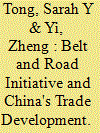

|
|
|
|
|
| Summary/Abstract |
It has been over six years since the idea of the Belt and Road Initiative (BRI) was first publicised. While the importance of BRI has been widely recognised, its impacts are wide-ranging and controversial. This article, by first reviewing existing studies, is a preliminary effort to assess the BRI's effect on China's trade development. The authors' analysis indicates that, six years after the initiative's implementation, the changes in China's trade relations with countries along the Belt and Road are limited, compared to those with other countries. Data has also shown that there are huge variations across regions within the Belt and Road countries in their trade relations with China. More in-depth studies are needed to enhance our understanding of the BRI's overall impacts.
|
|
|
|
|
|
|
|
|
|
|
|
|
|
|
|
| 2 |
ID:
161971
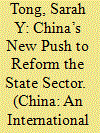

|
|
|
|
|
| Summary/Abstract |
There have been high expectations for renewed reforms of China’s numerous and hugely diverse state-owned enterprises (SOEs). Directed by two important documents of top-level design, the reform plan incorporates useful policy elements, such as allowing the market to play a larger role and making the shift from asset to capital management, all of which demonstrate a move in the right direction. However, many issues, especially the role of the Party and SOE monopoly, remain unsolved and need to be further illuminated. Nevertheless, encouraging progress has been made via pilot programmes and local experiments in areas such as mixed ownership reforms and making the shift to capital management.
|
|
|
|
|
|
|
|
|
|
|
|
|
|
|
|
| 3 |
ID:
161206
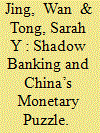

|
|
|
|
|
| Summary/Abstract |
There are two monetary puzzles in post-2008 China—the money multiplier had risen considerably in magnitude and the rapidly expanding money supply, M2, has not led to a surge in consumer price index (CPI). To untangle the puzzles, the authors relaxed some of the assumptions in the conventional quantity theory of money (QTM) and introduced endogeneity into the money multiplier, taking into account the rapid expansion of shadow banking. This unveils a mechanism that links monetary authority and credit allocation among sectors. An important policy implication is that controlling the relative size of shadow banking can help improve the effectiveness of China’s monetary policies.
|
|
|
|
|
|
|
|
|
|
|
|
|
|
|
|
| 4 |
ID:
060888
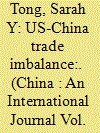

|
|
|
| 5 |
ID:
090794
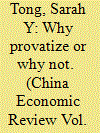

|
|
|
|
|
| Publication |
2009.
|
| Summary/Abstract |
Using a firm-level panel dataset which covers over 50,000 state-owned enterprises (SOEs) across China for the years 1998 to 2003, we attempt to answer the question of why some SOEs are privatized while others remain under state control. By applying a Heckman two-stage procedure, we investigate the causes that determine SOE privatization outcome. We find that the factors most conducive for privatization are the rise of competition, the increase of FDI concentration of both industries and provinces, and the hardening of SOEs' budget constraints. Moreover, it is shown that relatively better performing SOEs, measured by per employee value-added, profitability, and export propensity, are more prone to privatization. However, we should be careful in interpreting this result, due to the problem of selection bias. Results of the first-stage selection equation suggest that many small and non-performing SOEs dropped out of the sample, possibility due to privatization. What we can conclude is that, among the remainders, the better performing SOEs are more likely to be privatized.
|
|
|
|
|
|
|
|
|
|
|
|
|
|
|
|
|
|
|
|
|